

Oppositional defiant disorder: MedlinePlus Medical Encyclopedia. Oppositional defiant disorder is a pattern of disobedient, hostile, and defiant behavior toward authority figures.

Causes This disorder is more common in boys than in girls. Some studies have shown that it affects 20% of school-age children. However, most experts believe this figure is high due to changing definitions of normal childhood behavior, and possible racial, cultural, and gender biases. This behavior typically starts by age 8, but it may start as early as the preschool years. Symptoms Actively does not follow adults' requestsAngry and resentful of othersArgues with adultsBlames others for own mistakesHas few or no friends or has lost friendsIs in constant trouble in schoolLoses temperSpiteful or seeks revengeTouchy or easily annoyed To fit this diagnosis, the pattern must last for at least 6 months and must be more than normal childhood misbehavior.
The pattern of behaviors must be different from those of other children around the same age and developmental level. What Causes ADHD? What is attention deficit hyperactivity disorder?
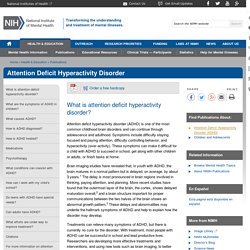
Attention deficit hyperactivity disorder (ADHD) is one of the most common childhood brain disorders and can continue through adolescence and adulthood. Symptoms include difficulty staying focused and paying attention, difficulty controlling behavior, and hyperactivity (over-activity). These symptoms can make it difficult for a child with ADHD to succeed in school, get along with other children or adults, or finish tasks at home. Brain imaging studies have revealed that, in youth with ADHD, the brain matures in a normal pattern but is delayed, on average, by about 3 years.1 The delay is most pronounced in brain regions involved in thinking, paying attention, and planning. SelfRegulationTipsandStrategies.pdf (application/pdf Object) Selfcontrol.pdf (application/pdf Object) Cognitive Strategy Instruction. Introduction What is Self Regulation?
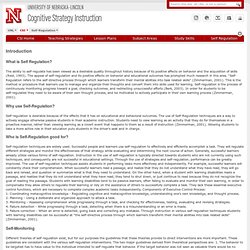
The ability to self-regulate has been viewed as a desirable quality throughout history because of its positive affects on behavior and the acquisition of skills (Reid, 1993). The appeal of self-regulation and its positive effects on behavior and educational outcomes has prompted much research in this area. "Self-Regulation refers to the self-directive process through which learners transform their mental abilities into task related skills" (Zimmerman, 2001). This is the method or procedure that learners use to manage and organize their thoughts and convert them into skills used for learning. Self-regulation Strategies for School-age Children. Committee for Children > Advocacy > Social-Emotional Learning > K-5 Self-Regulation Skills. Social-Emotional Learning Programs Work We all want students to succeed—in school and in life.

Research tells us that socially and emotionally competent students are more likely to experience this success (Raver, 2002). The Second Step program for Kindergarten through Grade 5 is a universal, classroom-based program that promotes the development of students' social-emotional competence. A recent meta-analysis found that students participating in such programs showed significant gains in social-emotional learning (SEL) skills, attitudes, and behaviors, as well as academic achievement (Durlak, Weissberg, Dymnicki, Taylor, & Schellinger, 2011).
It also found that school staff were quite successful in delivering SEL programs (Durlak et al., 2011). Making Our Program Work Better A goal for the new K–5 Second Step program was to improve the program's positive impact on students' school success. Self-Regulation_Florez_OnlineJuly2011.pdf (application/pdf Object) Occupational therapy, autism and tactics of self-regulation. Brian Field Occupational Therapy, or “OT,” is frequently incorporated into autism therapy regimens to help, among other things, stimulate a balance between the body and mind that can help focus the child.
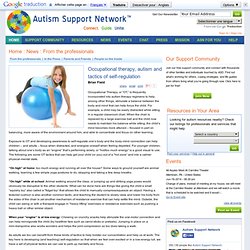
For example, a child may be easily distracted while sitting in a regular classroom chair. When the chair is replaced by a large exercise ball and the child now needs to maintain his balance while sitting, the child’s mind becomes more attuned – focused in part on balancing, more aware of the environment around him, and able to concentrate and focus on other learning. Exposure to OT and developing awareness to self-regulate one’s body and the body-mind connection can help children – and adults – focus when distracted, and energize oneself when feeling depleted. For younger children, talking about one’s body as an “engine” that’s performing slowly, or “hot/too much energy” is a good visual to use.
“On high” at home: too much energy and running all over the house? Help for Children, Teenagers and Young Adults with Bipolar Disorder. Many children and teenagers who suffer from bipolar disorder have not been diagnosed appropriately.
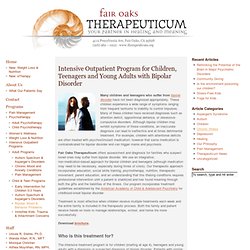
These children experience a wide range of symptoms ranging from frequent tantrums to inability to control impulses. Many of these children have received diagnoses such as attention deficit, oppositional defiance, or obsessive-compulsive disorders. Although bipolar children may exhibit symptoms of those conditions, an inaccurate diagnosis can lead to ineffective and at times detrimental treatment. Bipolar Support and Self-Help: Living with Bipolar Disorder. Living with bipolar disorder: What you can do to help yourself Living well with bipolar disorder requires certain adjustments.
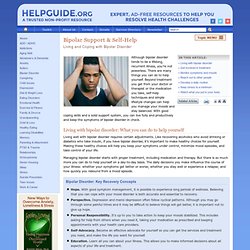
Like recovering alcoholics who avoid drinking or diabetics who take insulin, if you have bipolar disorder, it’s important to make healthy choices for yourself. Making these healthy choices will help you keep your symptoms under control, minimize mood episodes, and take control of your life. Managing bipolar disorder starts with proper treatment, including medication and therapy.
But there is so much more you can do to help yourself on a day-to-day basis. Bipolar Disorder: Key Recovery Concepts Hope. Source: Depression and Bipolar Support Alliance Bipolar disorder support tip #1: Get involved in your treatment Be a full and active participant in your own treatment. Using what you’ve learned about bipolar disorder, collaborate with your doctor or therapist in the treatment planning process. Other tips for successful bipolar disorder treatment: Be patient. Close Suicide. Keyword: affect regulation.